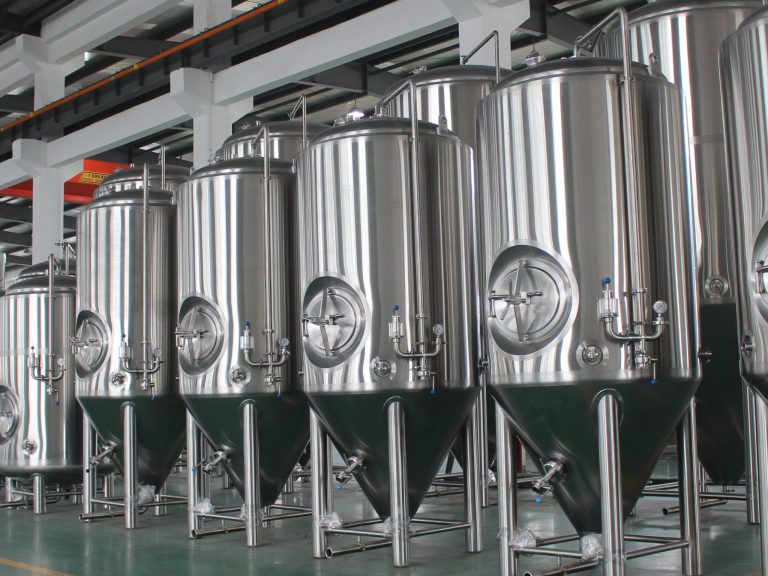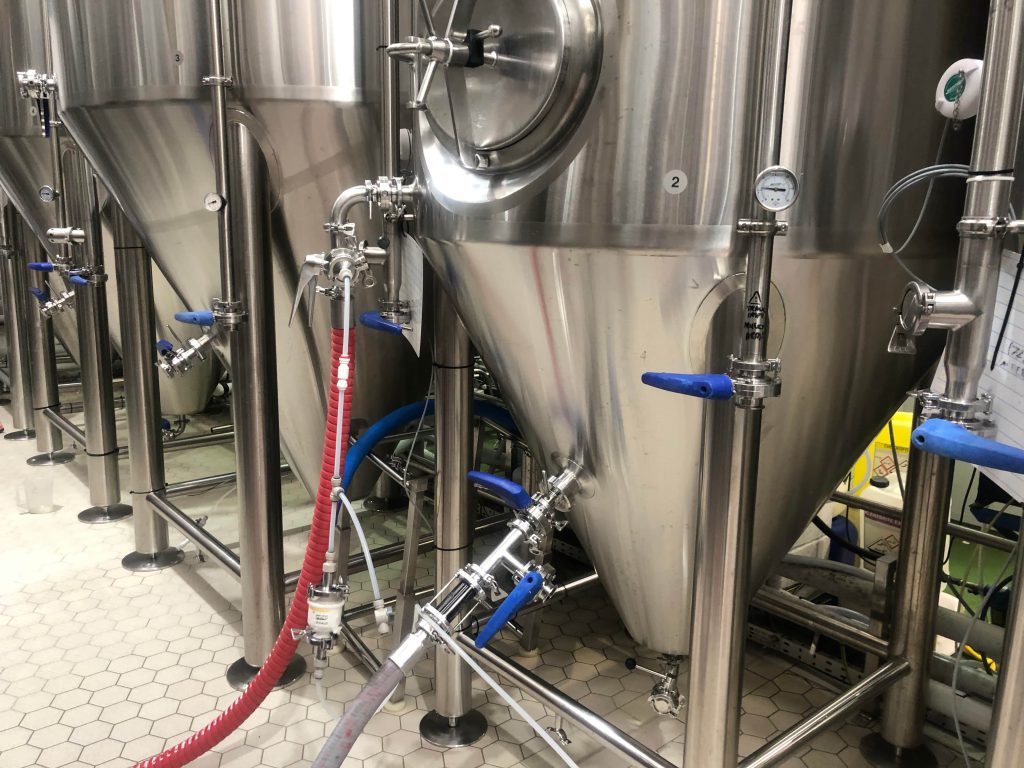Invoering

Craftbrouwen is de afgelopen tien jaar enorm populair geworden en met deze toenemende interesse komt er meer nadruk op kwaliteit en techniek. Van de vele gereedschappen en apparatuur die bij thuisbrouwen worden gebruikt, springt het fermentatievat met waterslot eruit als een cruciaal onderdeel. Deze blogpost gaat dieper in op de voordelen van het gebruik van een fermentatievat met waterslot, onderzoekt de voordelen ervan, hoe het zich verhoudt tot andere opties en beantwoordt veelgestelde vragen over het gebruik ervan. Aan het einde van deze uitgebreide gids begrijpt u waarom dit stuk apparatuur essentieel is voor succesvol craftbrouwen.
Wat is een Fermentatievat met waterslot?
Een fermentatievat met waterslot is een gespecialiseerde container die is ontworpen om het wort of bier vast te houden tijdens het fermentatieproces. Het vat is uitgerust met een waterslot, een apparaat dat gassen die tijdens de fermentatie worden geproduceerd laat ontsnappen, terwijl buitenlucht en verontreinigingen niet kunnen binnendringen. Deze opstelling is cruciaal voor het behoud van de integriteit van het fermentatieproces en het bereiken van de gewenste kwaliteit van het eindproduct.
De componenten van een gistingsvat met waterslot
- Fermentatievat: Dit vat is meestal gemaakt van glas, plastic of roestvrij staal en is de plek waar het wort wordt gefermenteerd. Glazen carboys zijn populair vanwege hun zichtbaarheid en het gemak van schoonmaken, terwijl plastic en roestvrijstalen opties duurzaamheid en weerstand tegen breuk bieden.
- Luchtsluis: Dit is een klein, vaak plastic apparaat dat in de bovenkant van het fermentatievat past. Het bevat meestal een waterslot waardoor koolstofdioxide kan ontsnappen, terwijl verontreinigingen en lucht worden geblokkeerd.
Voordelen van het gebruik van een Fermentatievat met waterslot
Voorkomt besmetting
Het belangrijkste voordeel van het gebruik van een fermentatievat met waterslot is het voorkomen van besmetting. Tijdens de fermentatie produceert gist koolstofdioxide, dat moet ontsnappen. Een waterslot laat deze gassen ontsnappen zonder dat er buitenlucht binnenkomt, wat bacteriën of wilde giststammen zou kunnen introduceren die het brouwsel zouden kunnen bederven. Deze beschermende functie helpt ervoor te zorgen dat het fermentatieproces niet besmet raakt en het eindproduct van hoge kwaliteit is.
Handhaaft consistente fermentatieomstandigheden
Consistentie is de sleutel bij het brouwen. Een fermentatievat met waterslot helpt om stabiele fermentatieomstandigheden te behouden door temperatuurschommelingen en blootstelling aan zuurstof te voorkomen. Blootstelling aan zuurstof kan leiden tot onaangename smaken en bederf, dus de luchtdichte afsluiting die het waterslot biedt, is cruciaal voor het behoud van de beoogde smaak en het aroma van het bier.
Vermindert het risico op explosie
Fermentatie produceert koolstofdioxide als bijproduct, wat druk in het vat kan opbouwen. Een luchtsluis laat overtollig gas veilig ontsnappen, waardoor het risico op drukopbouw en mogelijke explosies wordt verminderd. Deze veiligheidsfunctie is met name belangrijk bij thuisbrouwen, waar drukbeheer cruciaal is.
Gemakkelijk te monitoren
Met een helder fermentatievat kunnen brouwers de voortgang van de fermentatie eenvoudig volgen. De watersluis biedt ook visuele signalen over de fermentatieactiviteit. Borrelen in de watersluis geeft aan dat de fermentatie plaatsvindt, terwijl een gebrek aan activiteit potentiële problemen kan signaleren. Deze zichtbaarheid helpt brouwers om tijdig aanpassingen te doen en een succesvol fermentatieproces te garanderen.
Verbetert smaak en aroma
Door besmetting en oxidatie te voorkomen, helpt een fermentatievat met waterslot de delicate smaken en aroma's van het bier te behouden. Dit resulteert in een schoner, verfijnder eindproduct. De gecontroleerde omgeving die het vat biedt, helpt gist efficiënter te werken, wat bijdraagt aan een betere smaakontwikkeling.
Maakt het opruimen gemakkelijker
Fermentatievaten met luchtsluizen zijn over het algemeen eenvoudig schoon te maken. Veel zijn ontworpen met brede openingen die grondige reiniging en ontsmetting mogelijk maken. Dit eenvoudige onderhoud helpt infecties te voorkomen en zorgt ervoor dat elke batch bier onder optimale omstandigheden wordt gebrouwen.
Veelzijdigheid in het brouwen
Fermentatievaten met luchtsluizen zijn veelzijdig en kunnen worden gebruikt voor verschillende soorten fermentatie, waaronder primaire en secundaire fermentatie. Deze aanpasbaarheid maakt ze geschikt voor een breed scala aan brouwstijlen en -technieken, of u nu ales, lagers of experimentele brouwsels brouwt.
Vergelijking van fermentatievaten: luchtsluis vs. geen luchtsluis

Om de voordelen van het gebruik van een fermentatievat met luchtsluis te illustreren, is het handig om het te vergelijken met fermentatievaten zonder luchtsluis. De onderstaande tabel schetst de belangrijkste verschillen tussen de twee opties.
| Functie | Fermentatievat met waterslot | Fermentatievat zonder waterslot |
|---|---|---|
| Besmettingspreventie | Hoog | Laag |
| Gasontlading | Gecontroleerd via luchtsluis | Kan handmatige ontgrendeling vereisen |
| Blootstelling aan zuurstof | Minimaal | Hoger risico |
| Drukbeheer | Effectief | Minder effectief |
| Gemakkelijk te monitoren | Visuele indicatoren voorzien | Minder zichtbaarheid |
| Behoud van smaak | Beter | Variabel |
| Opruimen | Eenvoudig | Kan variëren |
Conclusie
Een fermentatievat met waterslot is een onmisbaar hulpmiddel voor ambachtelijke brouwers die hoogwaardige resultaten willen behalen. De voordelen ervan, waaronder het voorkomen van contaminatie, consistente fermentatieomstandigheden en een verbeterde smaakbehoud, maken het een waardevolle investering voor zowel beginnende als ervaren brouwers. Door te begrijpen hoe deze apparatuur het brouwproces verbetert, kunt u beter geïnformeerde beslissingen nemen en de kwaliteit van uw zelfgebrouwen bier verbeteren.
FAQ
V: Hoe maak ik mijn apparaat goed schoon en ontsmet ik het? gistingsvat met waterslot?
A:Om uw fermentatievat schoon te maken, demonteert u de waterslot en wast u alle onderdelen grondig met warm, sopig water. Gebruik een flessenborstel voor moeilijk bereikbare plekken. Spoel goed af en ontsmet met een geschikt brouwontsmettingsmiddel. Zorg ervoor dat alle onderdelen volledig droog zijn voordat u ze weer in elkaar zet.
V: Kan ik een fermentatievat met waterslot gebruiken voor zowel primaire als secundaire fermentatie?
A:Ja, fermentatievaten met watersloten zijn veelzijdig en kunnen worden gebruikt voor zowel primaire als secundaire fermentatie. Het waterslot helpt bij het controleren van gasafgifte en voorkomt contaminatie in beide fasen.
V: Hoe vaak moet ik de luchtsluis van mijn fermentatievat?
A: Luchtsloten hoeven over het algemeen niet vaak vervangen te worden. Als u echter scheuren, lekken of een niet meer effectieve afdichting opmerkt, is het een goed idee om het luchtslot te vervangen om de juiste fermentatieomstandigheden te behouden.
V:Welk formaat fermentatievat met waterslot moet ik gebruiken?
A: De grootte van het fermentatievat hangt af van de batchgrootte van uw bier. Veelvoorkomende maten variëren van 1 gallon tot 6,5 gallon (of groter). Zorg ervoor dat de grootte van het vat geschikt is voor het volume wort dat u fermenteert om problemen met overlopen en drukopbouw te voorkomen.
V:Kan ik een waterslot gebruiken met een niet-glazen fermentatievat?
A:Ja, watersloten kunnen worden gebruikt met verschillende soorten fermentatievaten, waaronder plastic en roestvrij staal. Zorg ervoor dat het waterslot goed past en dat het vat goed is afgesloten om besmetting te voorkomen.

